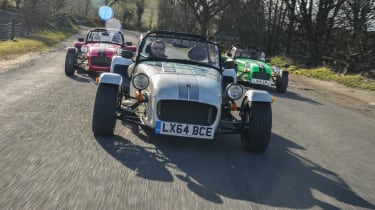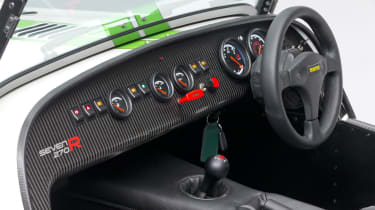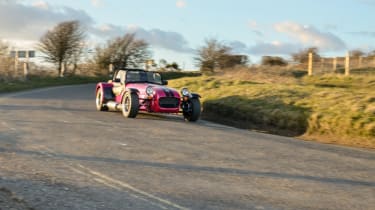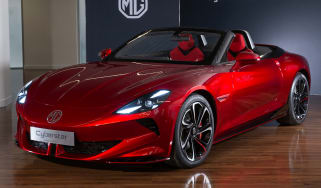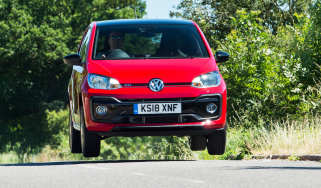Caterham Seven review - 270, 360, 420 and more tested
Simplified range, but none of the Seven magic has been lost
What is it?
The new, simplified range of Caterham Sevens. There are now just five core models, bookended by the sweet little three-cylinder 160 at the lower end and the fire-breathing supercharged 620R monster at the other. In the middle we now have the 270, 360 and 420 models.
Each of those can be specified in S or R trim. The former is geared towards road use and includes such luxuries as a carpet (these are Caterhams…) and leather seats. The R versions, which we’re testing here, are very much biased towards fast road and track driving. To that end they come fitted with a limited slip differential, four-point harnesses, composite race seats and trackday tyres.
Engine, transmission and 0-60mph time
The 270 is powered by Ford’s new 1.6-litre Sigma engine. It uses variable valve timing and delivers 135bhp – up 10bhp compared to the Roadsport 125 that this model replaces. 60mph is dealt with in 5.0 seconds flat and the top speed is 122mph.
Ford’s familiar 2-litre Duratec engine powers the 360 and 420 models, although it features a dry sump in the latter. With 180bhp and 210bhp respectively, the 360 and 420 will reach 60mph in 4.8 and 4.0 seconds. Top speeds are 130mph and 136mph.
More reviews
Group tests
Reviews
Five-speed manual gearboxes are fitted as standard with six-speed units available as optional extras. The 270 and 420 models that we tested were fitted with the six-speeder.
Technical highlights
Low weight is, as it’s always been, central to the Caterham Seven proposition. The 270 weighs from 540kg, which gives it a power-to-weight ratio of 250bhp/ton – about the same as a Porsche 911.
The 360 is a little heavier at 560kg, but with its extra power it betters the 270’s power-to-weight ratio by some 71bhp/ton. The 420 weighs the same as the 360 and manages 375bhp/ton – just a few points shy of the Ferrari 458 Italia.
All three models run on double wishbone front suspension with semi-independent de Dion setups at the rear. They each came fitted with 13-inch Avon trackday rubber – ZZ-S on the 270 and 360 and the yet more focused ZZ-R on the 420.
What’s it like to drive?
As ever, all three versions are an absolute hoot. We went directly to a racetrack to put the three new Sevens through their paces, but we will get them back in during the next few weeks to try them out on the open road.
Like every Seven that has gone before each of these new models feels alive and agile in a way that few others road cars can ever hope to replicate. They have steering to die for, incredible brake pedal feel and an unrivalled sense of connection between man and machine. All of that is a given – so let’s focus instead on what distinguishes these three models from one another.
"As ever, the caterham feels tiny, sparse but also incredibly evocative. It bombards you with information."-Jethro Bovingdon-evo 209
The 270 wears a six-inch tyre on the rear axle rather than the eight-inch rubber that the 360 and 420 use. With a smaller rear contact patch the 270 is every bit as adjustable on the throttle as the more powerful models, which makes it just as much fun, but it delivers its thrills at lower speeds.
It’s actually easier to induce a slide in the 270 because the transition into slip is more progressive – and there’s still plenty of power to sustain that slide. This test car was setup to be exploitable and fun, rather than sharp and edgy. On the circuit it just feels incredibly sweet and perfectly balanced.
Even with its modest 135bhp it feels like all the Seven you could need. The six-speed ‘box shifts very cleanly and crisply, too. With time, however, you might well feel as though you’d mastered the 270’s approachable dynamics and begin to crave more power – particularly if you fancied a spot of competitive hillclimbing or sprinting.
The 360 immediately feels brawnier and torquier in the way it accelerates, but still with a vibrant top end. The six-speed gearbox of the 270 test car was preferable to this 360’s five-speeder – it doesn’t feel caught between ratios and the shift action was sweeter.
As it was set up on the day the 360 had a little more understeer on turn in and better traction despite the extra power – thank the wider rear tyres for that. The consequence is that the 360 felt less playful through the corners than the 270 to begin with, but soon enough you’ll learn to manage the initial understeer by checking your entry speed or by turning in on the brakes.
That’ll see the front end dart into the apex in proper Seven fashion. From that point on it takes only a healthy boot full of throttle set the 360 up in that lovely four-tyres-sliding stance that makes Sevens so intoxicating. It requires a little more effort and understanding than the 270, but the results are worth it.
The 420, meanwhile, was an altogether more focused machine – both because of its setup and stickier tyres. Whereas the lower powered models can be danced up to their limits and held there – the driver taking liberties and trying different techniques without concern – the 420 wants a more deliberate approach.
Of course, there is a great deal that can be done with the individual set ups of these cars, but as tested the 420 was a spiky beast. It mightn’t have been as playful and exploitable as its stablemates, but if you take the time to learn how to get the best out of it the 420 does become hugely enjoyable. It demands a tidier driving style, it punishes careless driving and it isn’t so benign when you do send it over the limit.
The trade-off, of course, is sheer on-circuit performance. Driven correctly the 420 is a much faster car than the 270 and 360 and there is an enduring joy in that challenge – but you’ll probably laugh out loud more often in the ‘lesser’ cars.
Rivals
Direct rivals are few and far between, but the Ariel Atom is a tempting alternative. It starts at £30,573, so it undercuts the mid-range 360 with the R kit by around £400, but it actually outguns the top-spec 420 by 35bhp. The Atom looks better value for money, then, but the Seven is marginally sharper to drive on track.
If a Seven is just too hardcore, the more useable Lotus Elise starts at £30,900. The 1.6-litre base model doesn’t offer the performance of even the 270, but the handling is every bit as captivating.
Price
The 270 starts at £22,995 and the 360 costs £26,995, rising to £29,995 for the 420. The S pack will cost an additional £2,995, while the R kit adds another £3,995 to the list price.
| 270 | 360 | 420 | |
| Engine | 4-cyl, 1596cc | 4-cyl, 1999cc | 4-cyl, 1999cc |
| Power | 135bhp @ 6800rpm | 180bhp @ 7300rpm | 210bhp @ 7600rpm |
| Torque | 122lb ft @ 4100rpm | 143lb ft @ 6100rpm | 150lb ft @ 6300rpm |
| 0-62mph | 5.0sec | 4.8sec | 3.8sec |
| Top speed | 122mph | 130mph | 136mph |
| Price | £22,995 | £26,995 | £29,995 |
